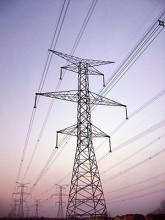Article
Electrical transmission lines transport electrical energy from power plants to substations. From the substations, electricity is then distributed to local users via power lines. Because the initial journey from the generators to the substations is considered bulk power transmission, electrical transmission lines must be able to carry high loads of energy. This is accomplished by wrapping cable strands of aluminum alloy, and sometimes copper, with strands of steel for reinforcement, and then breaking up and increasing voltage with circuit breakers and transformers in order to reduce resistance as electricity travels across the lines.
"All lined up, Brampton, Ontario, Canada, April 18, 2008" by Ian Muttoo is licensed under CC BY-SA.
Manuscripts
References
Hughes, Thomas Parke
1983 Networks of Power: Electrification in Western Society, 1880-1930. Baltimore: Johns
Hopkins University Press.

